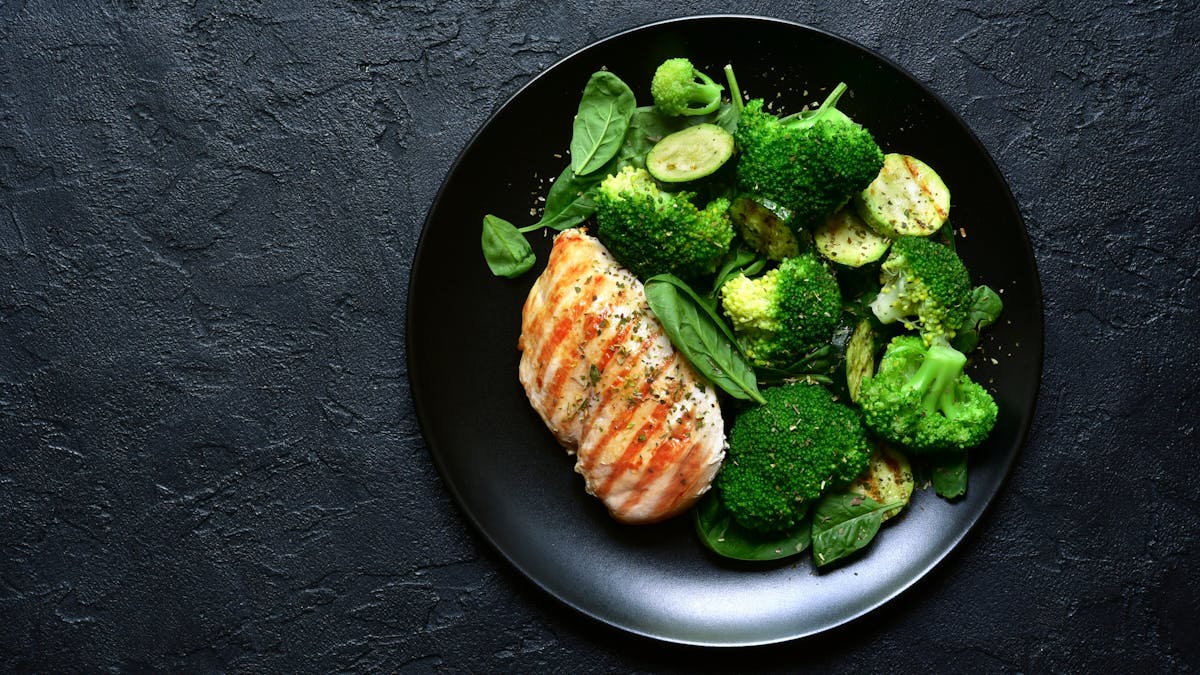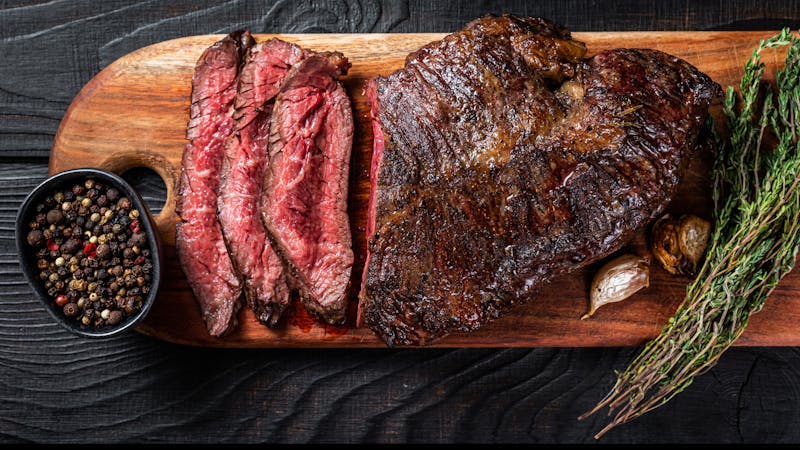The science of energy density and satiety
Evidence based
Eating more foods with a lower energy density could be one key to improving your satiety level — meaning your ability to eat fewer calories with minimal hunger. And eating fewer calories with minimal hunger can be a key to achieving healthy weight loss and improved body composition.
But focusing on energy density alone may not be a complete solution for hunger and healthy weight loss. So, what do we really mean when we say eating foods with a lower energy density helps improve satiety?
We use the term “satiety” to mean the comfortably full feeling you get when you aren’t hungry or seeking more food. In this sense, satiety encompasses three types of satisfaction:
- short-term satiation: the feeling of wanting to stop eating during a meal
- medium-term satiety: feeling satisfied between meals
- longer-term satiety: reduced hunger levels over weeks and months


As we detail in our guides on satiety and our satiety score, an effective way to succeed with healthy weight loss is to focus on food with:
- higher protein percentage
- lower energy density
- higher fiber content
- lower hedonic factors
This guide explains the science that supports lower energy density as a key player and details how eating foods with a lower energy density could improve satiety— at least in the short term.
What is energy density?
Energy density refers to how many calories a food has per gram or ounce. Foods with high energy density have lots of calories packed into a given weight of food. Foods with low energy density offer few calories in the same weight of food.
For example, potato chips, donuts, and oils have high energy density. You don’t have to consume many grams or ounces of these foods to get a lot of calories.
Asparagus and broccoli have low energy density. It takes a large amount to provide a lot of calories. When you eat a lot of asparagus and broccoli, you’ll fill up your stomach and get plenty of nutrients without ingesting many calories.
Foods with low energy density tend to have more water, more fiber, and less fat.
Examples include:
- leafy green vegetables such as spinach, chard, lettuce, and kale
- fibrous vegetables such as zucchini, asparagus, cabbage, cauliflower, and broccoli
- fruits and berries
- egg whites
- soy and other legumes such as beans, peas, and lentils
- low fat dairy such as Greek yogurt and cottage cheese
- lean meat, fish, seafood, and chicken
Foods with high energy density tend to have low levels of water and fiber and more fat.
Examples include
- ultra-processed foods such as fries, chips, and cookies
- all oils, including coconut, safflower, and olive oil
- most nuts, including pecans, brazil nuts, walnuts, cashews, almonds, and nut butters
- butter
- processed meats like bacon, pepperoni, and salami
- high fat cheeses such as Gruyere, Swiss, and blue cheese
Multiple studies report that lower-energy-density diets correlate with improved satiety and weight loss compared to higher-energy-density diets. Part of the improved satiety and weight loss may be directly related to the lower-energy-density foods being higher in fiber and water and lower in starch, sugar, and fat.
The science supporting foods with a lower energy density
One study back in 1983 demonstrated that people who ate foods with a lower energy density ate half as many calories as those who ate foods with a higher energy density. Participants who ate foods with a lower energy density also took 33% longer to finish their meal, so some question whether the difference in calorie intake was caused by the eating time or the energy density.
In truth, it may not matter. The slower pace of eating foods with a lower energy density happens naturally, without purposely trying to do it. Compare that to trying to eat a donut or bag of potato chips slowly. That’s hard to do!
Other mechanisms of lower-energy-density foods’ beneficial effects are reduced feelings of hunger and increased satiety. In the study discussed above, participants reported decreased cravings and greater control over eating.
Multiple randomized trials and observational studies support the idea that eating foods with a lower energy density reduces calorie intake despite higher food volume. However, as one study reported, the beneficial effects of lower energy density on satiety likely apply to solid foods but not to liquids.
Foods with higher energy density also tend to be more palatable. Therefore, a food’s taste could be part of the driving force to eat more, which suggests there may be multiple reasons for excess intake and weight gain.
Energy density and ketogenic diets
Some experts question whether this research on energy density applies to all dietary patterns, regardless of the macronutrient composition.
One systematic review of studies that manipulated energy density found that eating foods with a lower energy density led to eating fewer calories. This relationship was true across a range of macronutrients. However, as with many energy density studies, the authors did not evaluate very low carb diets.
Could ketogenic diets be the exception? Unfortunately, comparing a low-energy-density keto diet to a high-energy-density keto diet hasn’t been studied with trials of sufficient length to allow for adaptation and provide a reliable answer.
But long-term studies of ketogenic diets report reduced calorie intake and increased weight loss, despite allowing unrestricted amounts of butter, oils, high fat dairy, and other foods with high energy density. So the power of energy density to affect the number of calories consumed may be blunted by keto.
Putting it all together
As we previously mentioned, we use satiety to encompass:
- short-term satiation: the feeling of wanting to stop eating during a meal
- medium-term satiety: feeling satisfied between meals
- longer-term satiety: reduced hunger levels over weeks and months
Eating low-energy-density foods may help with satiation and short-term satiety.
This hypothesis makes sense, practically. Eating a whole plate of spinach and asparagus may make you feel full fairly quickly (from the food volume and stomach expansion). But your calorie and protein intake would be deficient — factors that may drive hunger over the longer term. Once the food volume is out of your stomach, and the stretch receptors are no longer triggered, hunger may return.
But some studies suggest that as long as you continue to eat low-energy-density foods, you tend to eat less over time and lose weight. We believe this is more likely to be the case when you combine low-energy-density foods with higher protein foods. Adding protein to food with a low energy density adds calories and nutrients, and will likely help with longer-term satiety.
So, although a specific characteristic of a food, like energy density, may help with satiety, combining low energy density with high protein percentage, high fiber, and low hedonic factors together is likely the best approach for long-term satiety and healthy weight loss.
The science of energy density and satiety – the evidence
This guide is written by Dr. Bret Scher, MD and was last updated on September 14, 2022. It was medically reviewed by Dr. Ted Naiman, MD on July 5, 2022.
The guide contains scientific references. You can find these in the notes throughout the text, and click the links to read the peer-reviewed scientific papers. When appropriate we include a grading of the strength of the evidence, with a link to our policy on this. Our evidence-based guides are updated at least once per year to reflect and reference the latest science on the topic.
All our evidence-based health guides are written or reviewed by medical doctors who are experts on the topic. To stay unbiased we show no ads, sell no physical products, and take no money from the industry. We’re fully funded by the people, via an optional membership. Most information at Diet Doctor is free forever.
Read more about our policies and work with evidence-based guides, nutritional controversies, our editorial team, and our medical review board.
Should you find any inaccuracy in this guide, please email andreas@dietdoctor.com.
Obesity 2014: Assessment of satiety depends on the energy density and portion size of the test meal [randomized trial; moderate evidence]
American Journal of Clinical Nutrition 2007: Dietary energy density in the treatment of obesity: a year-long trial comparing 2 weight-loss diets [randomized trial; moderate evidence]
American Journal of Clinical Nutrition 2001: Energy density of foods affects energy intake across multiple levels of fat content in lean and obese women [randomized trial; moderate evidence]
Physiology & Behavior 2009: The relationship between dietary energy density and energy intake [overview article; ungraded]
Journal of Nutrition and Metabolism 2019: The role of fiber in energy balance [overview article; ungraded]
American Journal of Clinical Nutrition 1983: The effects of high and low energy density diets on satiety, energy intake, and eating time of obese and nonobese subjects [randomized trial; moderate evidence]
This study supports the idea that foods with lower energy density reduce feelings of hunger:
Journal of Nutrition 2018: A low energy-dense diet in the context of a weight-management program affects appetite control in overweight and obese women [randomized trial; moderate evidence]
The following randomized trial demonstrated that those eating the lowest-energy-density meals reduced calories the most and lost more weight:
American Journal of Clinical Nutrition 2007: Reductions in dietary energy density are associated with weight loss in overweight and obese participants in the PREMIER trial [randomized trial; moderate evidence]
And the following trial reported that within the context of high carb diets, reducing fat led to weight loss averaging 14 pounds (6.4 kilos) at 1 year; but the group that added fruits and veggies and achieved a lower energy density lost 17 pounds (7.9 kilos):
American Journal of Clinical Nutrition 2007: Dietary energy density in the treatment of obesity: a year-long trial comparing 2 weight-loss diets [randomized trial; moderate evidence]
Finally, the following observational study demonstrated that those eating lower energy density foods ate more food but fewer calories.
American Journal of Clinical Nutrition 2006: Dietary energy density is associated with energy intake and weight status in US adults [nutritional epidemiology study, very weak evidence]
European Journal of Clinical Nutrition 2009: Energy density of foods, but not beverages, is positively associated with body mass index in adult women [nutritional epidemiology study, very weak evidence]
Nutrition Reviews 1998: Energy density, palatability, and satiety: implications for weight control [overview article; ungraded]
International Journal of Behavioral Nutrition and Physical Activity 2022: Calorie reformulation: a systematic review and meta-analysis examining the effect of manipulating food energy density on daily energy intake [Meta analysis of randomized and nonrandomized trials; moderate evidence]
The authors of the following study concluded that keto diets led to higher caloric intake than plant-based, higher carb diets. However, the study was only two weeks long, and there was a significant decrease in caloric intake from week one to week two while eating a keto diet. Given the known adaptation period for a keto diet, it’s important to follow people for longer than two weeks to measure the true effect of a keto diet on caloric intake.
Nature Medicine 2021: Effect of a plant-based, low-fat diet versus an animal-based, ketogenic diet on ad libitum energy intake [randomized trial; moderate evidence]
Obesity Reviews 2015: Do ketogenic diets really suppress appetite? A systematic review and meta-analysis [strong evidence]
European Journal of Clinical Nutrition 2013: Ketosis and appetite-mediating nutrients and hormones after weight loss [non-controlled study; weak evidence]
Advances in Nutrition 2014: Energy density, energy intake, and body weight regulation in adults [overview article; ungraded]
One study reports that even adding air to food — for example, beating egg whites — increases the satiating effect. (Since air has no weight, it does not change the energy density of a food, but it changes the volume.) And, since air has no calories, protein, or nutrients, it is unlikely to help beyond the immediate short term.
American Journal of Clinical Nutrition 2000: Increasing the volume of a food by incorporating air affects satiety in men [randomized trial; moderate evidence]
Obesity2006: Weight maintenance 2 years after participation in a weight loss program promoting low-energy density foods [nutritional epidemiology study, very weak evidence]
American Journal of Clinical Nutrition 2007: Dietary energy density in the treatment of obesity: a year-long trial comparing 2 weight-loss diets [randomized trial; moderate evidence]








